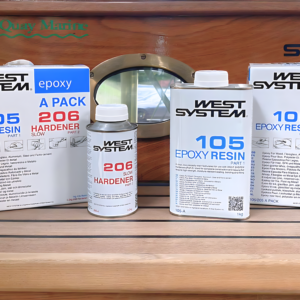Epoxy Basics: Amine blush when working with epoxy: What you need to know
Amine blush is a waxy bi-product that appears as epoxy cures. It can prevent varnishes and other coatings from bonding. But, as David Johnson explains, there are simple steps you can take to avoid blush becoming a problem.
What is amine blush?
As epoxy cures in contact with moisture, a greasy or waxy film known as amine blush is produced. This film is created on the surface of the cured epoxy. Its appearance alters depending on the amount of moisture in the air, but it’s usually more noticeable in cool, moist conditions. You might struggle to see it at all, or it may appear as a thin, greasy or dull layer.
Why is amine blush a problem?
In itself amine blush isn’t a problem: it’s the effects it causes that are the issue. If you continue working without removing the blush, it will prevent varnishes, further coats of epoxy and other substrates from bonding effectively. Try sanding an amine blush-covered surface and it will clog your sandpaper and cause the blush to penetrate your work more deeply.
Can you prevent amine blush from forming?
You can’t stop blush appearing, but by using WEST SYSTEM® 872-878 Peel Ply you can get around the problem – because amine blush forms on the peel ply, not on your cured epoxy. Peel ply is a finely woven nylon fabric, that will not bond to epoxy. So simply follow the instructions to apply peel ply to your work; ensure that the peel ply is thoroughly wetted out, let your epoxy cure and then remove the peel ply once cured and before applying the next coating. The blush will have formed on the peel ply, rather than on the epoxy. Once the peel ply is removed, you can carry on with your work as the peel ply’s fine woven pattern is impressed into the epoxy coating, creating a ready to bond to graded textured surface.
How can you get remove amine blush?
Amine blush is water-soluble, so it’s very simple to clean away. All you need to do is reach for a plant spray container, some warm soapy water and a Scotch Brite pad. Spray the affected surface with the water, wash thoroughly using the pad, wipe dry with paper towels and you’re done. It’s that easy.
Do all epoxies create amine blush?
While slower hardeners such as WEST SYSTEM 209 Extra Slow Hardener™ and 207 Special Coating Hardener®, will create less blush than faster-curing epoxies, in my experience it’s best to assume that some amine blush will form whenever you’re using an amine based epoxy system. After all, it’s extremely straightforward and quick to get rid of, while the alternative – assuming that no blush is present, only to discover that it is after you’ve tried to sand or bond to the surface – can be more painful and a lot more time-consuming.
Got an epoxy question you’d like answered by our epoxy experts? Get in touch today.
Image credit: https://www.amtcomposites.co.za/news/colder-temperatures-are-coming%E2%80%A6beware



